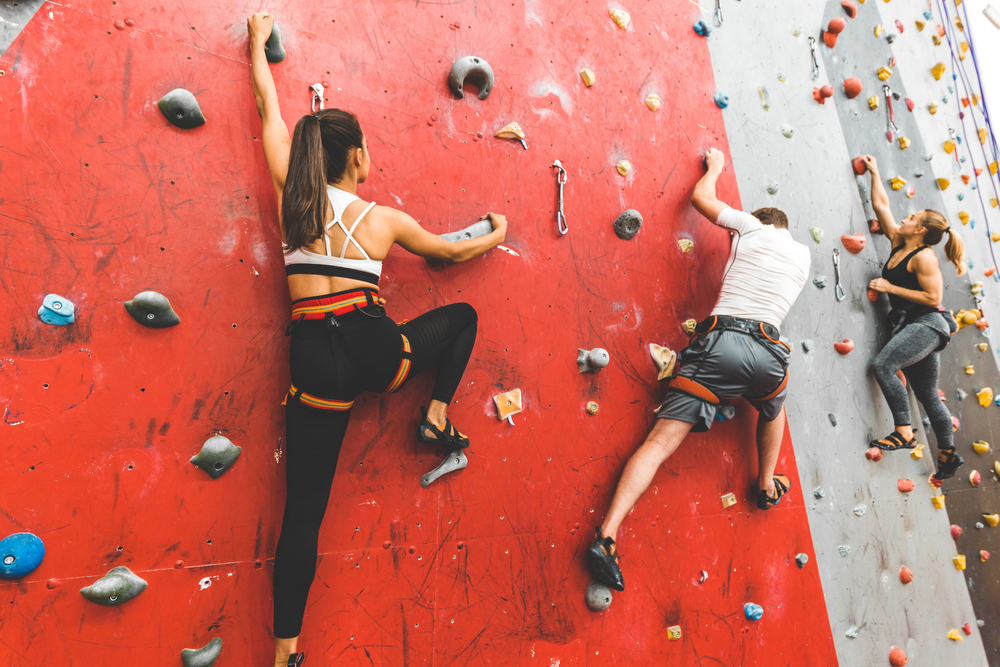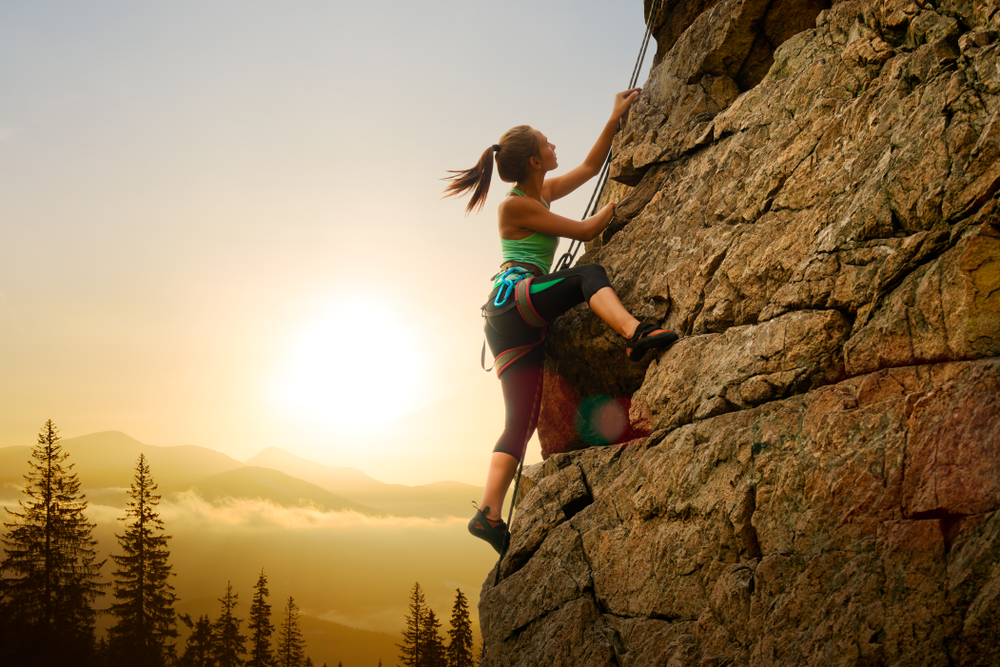Maybe are considering adding rock climbing into your workout routine. Or perhaps you have just started and may find yourself wondering if this activity is right for your fitness goals. Rock climbing is invigorating, empowering, and fun, but is it a good workout?
Rock climbing is an excellent comprehensive, full-body workout. Whether you are working out indoors or climbing real rock surfaces outdoors, your muscles, heart, and mind will thank you. Rock climbing is great for those looking for weight loss, aerobic or muscle-building workouts. With these benefits in mind, we can easily say that rock climbing is indeed a great workout.
Now that we have an idea of the many benefits that rock climbing provides, we’ll go into more detail. Let’s dig in!
Contents
Outdoor vs. Indoor Rock Climbing
Although climbing indoors still gives you all the great benefits of climbing, it has been proven that climbing outdoors can burn just a bit more calories than climbing indoors.
This is due to a few factors:
- The adrenaline of climbing outdoors
- The terrain that could include a hike to get to the mountain you are climbing or a harder climb than you anticipated
- The extra weight you will have to carry if you are using a traditional climbing system (or “trad climb” as the veterans call it)
How Many Calories Can You Burn Rock Climbing?
Of course, this will vary for each person based on their individual body type. On average, a person burns about 400-550 calories per hour doing a low-intensity climb, and about 575-775 calories per hour for a high-intensity climb.
Below is a chart that breaks down the calorie burn for the different activities that make up rock climbing. As we mentioned before, this is simply an average calculation of caloric burn.
If you are looking for a more accurate calculation based on your own body, you can use the formula (MET x bodyweight in Kg x 3.5) ÷ 200.
| Activity | MET | Calories Burned |
|---|---|---|
| Rappelling | 5 | 358 |
| Ascending or traversing rock, low-to-moderate difficulty | 5.8 | 415 |
| Ascending rock, high difficulty | 7.5 | 537 |
| Rock or mountain climbing | 8 | 573 |
Is Rock Climbing Indoors a Good Workout?
Whether you are rock climbing indoors at a local rock-climbing gym or out in the mountains climbing real rocks, this activity is still a great workout. This is because, even indoors, your body is still using all of those muscles to keep your body close to the wall, hold your body weight above the ground and pull yourself up to the next rock formation. These combined actions meld to form one killer workout!
Is Rock Climbing Good for Weight Loss?
Rock climbing is a comprehensive and dynamic workout that combines stretching, cardio and the use of your muscles, making this type of workout great for weight loss. The amount of weight you can lose while participating in this workout has a lot of factors that play into it.
Being consistent with a workout plan and gaining intensity, as well as making other lifestyle changes such as diet, all play into the amount of weight an individual can lose. Additionally, once you up the intensity of your workout and start climbing on a consistent basis, you may notice more muscle forming which will skew your weight loss numbers, since we know that muscle weighs more than fat.
Is Rock Climbing Good Cardio?
Because rock climbing can get your heart rate to levels between 120-180, it is deemed a great aerobic or cardio exercise!
The intensity of your workout will depend on how hard you push yourself, and the limits your body can take.
It has actually been proven that rock climbing for one hour has the same cardiovascular benefits as a one-hour spin class!
Does Rock Climbing Build Muscle?
As you can imagine, with all of the small muscle movements being made such as stepping, pulling, holding, and clenching that happen during a climb, it’s no wonder that rock climbing is a great exercise to build muscle, on top of being great for weight loss and cardiovascular health.
Rock climbing is a full-body workout, meaning there are not many parts of your body that don’t get used during this activity. If you’re interested in the details, we’ve provided a full breakdown below of what and how your muscles get used when you’re surfing those rocks.
- Shoulders and Upper Back: these are used when you are stretching your arms up to your next movement and pulling your body up.
- Arms: this includes your forearms, biceps, and triceps – which are also used when pulling your body up to the next movement. In fact, the forearm is the first muscle to become strong among new climbers. This muscle is used to form a strong grip on the rock you’re holding on to.
- Core: your core or abdomen is an extremely important part of the balance of our bodies, which comes into play a lot during climbing. Your core will probably be engaged without you even noticing. Your core is responsible for stabilizing your body, whether trying to hold yourself close to the wall or keeping your balance while you reach for that next rock.
- Lower Body: engaging muscles such as the hip flexors, calves, glutes, and quads are an important part of bending, extending, and launching our bodies upward. You’ll find that when you’re pulling yourself up, it’s best to let your legs do most of the work and let your arms guide your body.
Benefits of Rock Climbing
As you can probably guess from reading this article, rock climbing has some pretty awesome benefits. It is great for weight loss, improving cardiovascular health, and building muscles. But there are also a few additional benefits to rock climbing!
1. Decrease BMI
Because of the cardiovascular nature of this activity paired with the amount of endurance needed, rock climbing is also a great way to decrease Body Mass Index. You’ll also find that your flexibility has improved due to the amount of stretching involved.
2. Improve Cognitive Function
Besides the benefits that rock climbing has on your body physically, it has also been proven to have mental health benefits as well. A study shows that those who participated in rock climbing consistently felt fewer feelings of anxiety and depression.
Activities that require our brains to use balance, muscle coordination, and spatial bearings could lead to improving a person’s memory and other cognitive abilities.
3. Social Experience
If you choose to rock climb in a class, group, or public setting, it may also be a great way to make friends and make new social adventures! You will probably find yourself discussing gear, and techniques and sharing tips and tricks along the way with fellow climbers.
Climbing in a group can be a fun experience that can lead to new places you never knew to climb.
Plus, it is great to have a friend with you when climbing in case you take a risky step and need assistance.
How Many Times a Week Should Your Rock Climb?
There is no limit to how much you should or should not rock climb. Although, if you are a beginner, it is important to go at a rate and intensity you are comfortable with to prevent any injuries.
If you push yourself too far, too fast, it may hinder your abilities rather than strengthen them. In fact, you may end up with a strain or pulled muscle.
Generally speaking, with any exercise, it is good to start off with a solid 3 times per week. Once you have gained experience and confidence, you can build up to rock climbing 4, 5, or even 6 days in a row. (Be sure to give yourself a rest day!)
Tips for a Good Rock-Climbing Workout
Now that we have covered the basics of rock climbing and just how good of a workout this can be for your body, let’s explore a few tips that will help you enhance your experience.
- Stretch Before and After – Rock climbing requires the use of most of the muscles in your body. It is important to warm them up before starting your workout. This will improve function and flexibility during your climb. Additionally, stretching after a workout is equally as important, as this will aid in your muscle’s recovery process
- Drink Water – This tip pertains to any form of exercise, but it is an essential one! Keeping your body hydrated allows you to work out longer, harder, and more often as it helps to replenish what you have lost during the workout. Hydration is the key to meeting any fitness goal!
- Breathe – This may seem simple, but you would be surprised at how many times we hold our breath during a strenuous workout. This is the exact opposite of what we should be doing. Deep breaths allow oxygen to flow through the body to our muscles, while lack of oxygen causes cramps and shaking. Taking a breath is also important for your mental state, as it helps us stay calm and centered.



